Motor Development
As you learned in Chapter 2, human movement starts well before birth, as the fetus floats weightlessly in amniotic fluid. After birth, the newborn's movements are jerky and relatively uncoordinated, in part because of physical and neurological immaturity and in part because the baby is experiencing the full effects of gravity for the first time. As you will see in this section, the story of how the uncoordinated newborn, a prisoner of gravity, becomes a competent toddler confidently exploring the environment is remarkably complicated.
189
Reflexes
Newborns start off with some tightly organized patterns of action known as neonatal reflexes. Some reflexes, such as withdrawal from a painful stimulus, have clear adaptive value; others have no known adaptive significance. In the grasping reflex, newborns close their fingers around anything that presses against the palm of their hand. When stroked on the cheek near their mouth, infants exhibit the rooting reflex, turning their head in the direction of the touch and opening their mouth. Thus, when their cheek comes into contact with their mother's breast, they turn toward the breast, opening their mouth as they do. Oral contact with the nipple then sets off a sucking reflex, followed by the swallowing reflex, both of which increase the baby's chance of getting nourishment and ultimately of surviving. These reflexes are not fully automatic; for example, a rooting reflex is more likely to occur when an infant is hungry.
No benefit is known to be associated with other reflexes, such as the tonic neck reflex: when an infant's head turns or is turned to one side, the arm on that side of the body extends, while the arm and knee on the other side flex. It is thought that the tonic neck reflex involves an effort by the baby to get and keep its hand in view (von Hofsten, 2004).

ELIZABETH CREWS/THE IMAGE WORKS
LAURENT/RAVONISON/BSIP/SCIENCE SOURCE/HOTO RESEARCHERS, INC.
CUSTOM MEDICAL STOCK PHOTO/ALAMY
190
The presence of strong reflexes at birth is a sign that the newborn's central nervous system is in good shape. Reflexes that are either unusually weak or unusually vigorous may signal brain damage. Most of the neonatal reflexes disappear on a regular schedule, although some—including coughing, sneezing, blinking, and withdrawing from pain—remain throughout life. Persistence of a neonatal reflex beyond the point at which it is expected to disappear can indicate a neurological problem.
Motor Milestones
Infants progress quickly in acquiring the basic movement patterns of our species, shown in Figure 5.9. As you will see, the achievement of each of the major “motor milestones” of infancy, especially walking, constitutes a major advance, and provides new ways for infants to interact with the world.

The average ages that Figure 5.9 gives for the development of each of these important motor skills are based on research with Western, primarily North American, infants. There are, of course, tremendous individual differences in the ages at which these milestones are achieved. Of particular interest is the fact that the degree to which motor skills are encouraged varies from one culture to another, and such variation can affect the course of motor development. Indeed, some cultures actively discourage early locomotion. In modern urban China, for example, infants are typically placed on beds and surrounded by thick pillows to keep them from crawling on the dirty floor (Campos et al., 2000). These restrictions make it difficult for infants to develop the muscle strength required to support their upper trunk, which is necessary for crawling. Among the Aché, a nomadic people who live in the rain forest of Paraguay, infants spend almost all of their first 3 years of life being carried by their mothers or kept very close to her because of safety concerns. These infants thus get relatively little opportunity early on to exercise their locomotor skills (Kaplan & Dove, 1987).
191
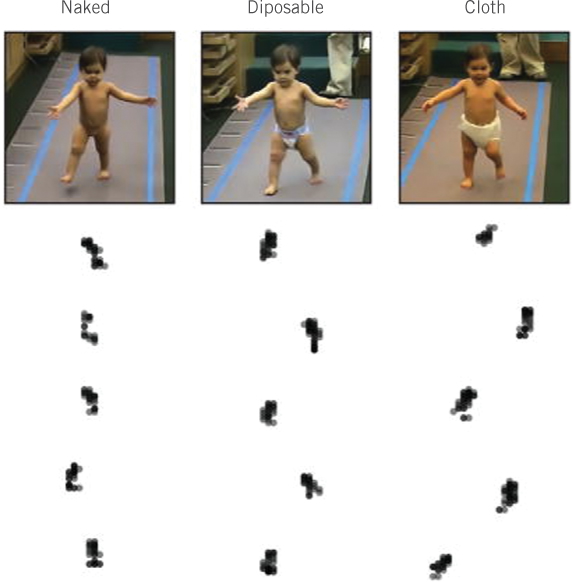
In direct contrast, the Kipsigis people in rural Kenya actively encourage the motor development of their infants; for example, they help their babies practice sitting by propping them up in shallow holes dug in the ground to support their backs (Super, 1976). Other groups, in West Africa and the West Indies, institute an aggressive program of massage, manipulation, and stimulation designed to facilitate their infants' motor development (A. Gottlieb, 2004; Hopkins & Westra, 1988).
These widely varying cultural practices can affect infants' development. Researchers have documented somewhat slower motor development in Aché and Chinese infants compared with the norms shown in Figure 5.9; Kipsigis babies and the infants who undergo exercise regimes, on the other hand, are advanced in their motor–skill development compared with North American infants. Even aspects of infant life that we take for granted in our own culture have an effect on motor development. In a recent study, researchers asked whether diapers—a relatively recent cultural invention—have an impact on walking behavior (Cole, Lingeman, & Adolph, 2012; see Figure 5.10). The researchers found that the same infants exhibited more mature walking behavior when tested naked than when tested diapered, despite the fact that these infants—all residents of New York City—were accustomed to wearing diapers and had rarely walked naked. These data beautifully demonstrate that cultural practices that are undertaken in one domain (toileting) can have unforeseen consequences in another domain (walking behavior).
Current Views of Motor Development
Impressed by the orderly acquisition of skills reflected in Figure 5.9, two early pioneers in the study of motor development, Arnold Gesell and Myrtle McGraw, concluded that infants' motor development is governed by brain maturation (Gesell & Thompson, 1938; McGraw, 1943). In contrast, current theorists, many of whom take a dynamic–systems approach (see Chapter 4), emphasize that early motor development results from a confluence of numerous factors that include developing neural mechanisms, increases in infants' strength, posture control, balance, and perceptual skills, as well as changes in body proportions and motivation (Bertenthal & Clifton, 1998; Lockman & Thelen, 1993; von Hofsten, 2004). (Box 5.3 offers a detailed account of a program of research exemplifying this approach.)
Think for a moment about how each of these factors plays a part in infants' gradual transition from newborns unable even to lift their head to toddlers who walk independently, holding their upper body erect while coordinating the movement of their legs that have grown strong enough to support their weight. Every milestone in this transition is fueled by what infants can perceive of the external world and their motivation to experience more of it. The vital role of motivation is especially clear in infants' determined efforts to attempt to walk when they can get around much more efficiently by crawling. Most parents—and many researchers—have the impression that infants derive pleasure from pushing the envelope of their motor skills.
192
BOX 5.3: a closer look “THE CASE OF THE DISAPPEARING REFLEX”
One of the primary proponents of the dynamic–systems point of view we discussed in Chapter 4 was Esther Thelen. Early research by Thelen and her colleagues provides an excellent example of this approach to investigating motor development, as well as a good example of how to formulate hypotheses and test them in general. In one study, they held infants under the arms and submerged them waist–deep in water. As you read the following paragraphs, see how soon you can figure out the rationale for this somewhat strange–sounding, but, in fact, extremely informative, experiment.
This particular study was one in a series of investigations of what Thelen (1995) referred to as “the case of the disappearing reflex.” The reflex in question, the stepping reflex, can be elicited by holding a newborn under the arms so that his or her feet touch a surface; the baby will reflexively perform stepping motions, lifting first one leg and then the other in a coordinated pattern as in walking. The reflex typically disappears at around 2 months of age. It was long assumed that the stepping reflex disappears from the infant's motor repertoire as a result of cortical maturation.
However, the results of a classic study by Zelazo, Zelazo, and Kolb (1972) were inconsistent with this view. In that research, 2–month–old infants were given extra practice exercising their stepping reflex; as a result, the infants continued to show the reflex long after it would otherwise have disappeared. Other research also showed persistence of the stepping pattern long beyond 2 months of age. For one thing, the rhythmical kicking that babies engage in when they are lying down on their back involves the same pattern of alternating leg movement as stepping does. However, unlike stepping, kicking continues throughout infancy (Thelen & Fisher, 1982). For another, when 7–month–olds (who neither walk nor typically show the stepping reflex) are supported on a moving treadmill, they step smartly (Thelen, 1986). If the stepping reflex can be prolonged or elicited long after it is supposedly scheduled to disappear, cortical maturation cannot account for its vanishing. Why then does it normally disappear?
A clue was provided by the observation that chubbier babies generally begin walking (and crawling) somewhat later than do slimmer ones. Thelen reasoned that infants' very rapid weight gain in the first few weeks after birth may cause their legs to get heavier faster than they get stronger. More strength is needed to step while upright than to kick while lying down, and more is needed to lift a fat leg than a thin one. Thus, Thelen hypothesized that the solution to the mystery might have more to do with brawn than with brains.
Thelen and her colleagues conducted two elegant experiments to test this hypothesis (Thelen, Fisher, & Ridley–Johnson, 1984). In one, the researchers put weights on the ankles of very young infants who still had a stepping reflex. The amount of weight was roughly equivalent to the amount of fat typically gained in the first few months. When the weight was added, the babies suddenly stopped stepping. In the second study, older infants who no longer showed a stepping reflex were suspended waist–deep in a tank of water. As predicted, the babies resumed stepping when the buoyancy of the water supported their weight. Thus, the scientific detective work of these investigators established that the normal disappearance of the stepping reflex is not caused by cortical maturation, as previously assumed. Rather, the movement pattern (and its neural basis) remains but is masked by the changing ratio of leg weight to strength. Only by considering multiple variables simultaneously was it possible to solve the mystery of the disappearing reflex.
The Expanding World of the Infant
Infants' mastery of each of the milestones shown in Figure 5.9 greatly expands their world: there is more to see when they can sit up, more to explore when they can reach for things themselves, and even more to discover when they can move about on their own. In this section, we consider some of the ways that motor development affects infants' experience of the world.
Reaching
The development of reaching sets off a minirevolution in the infant's life: “once infants can reach for and grasp objects, they no longer have to wait for the world to come to them” (Bertenthal & Clifton, 1998). However, reaching takes time to develop. That is because, as discussed in Chapter 4, this seemingly simple behavior actually involves a complex interaction of multiple, independent components, including muscle development, postural control, development of various perceptual and motor skills, and so on.
193
Initially, infants are limited to prereaching movements—clumsy swiping toward the general vicinity of objects they see (von Hofsten, 1982). At around 3 to 4 months of age, they begin successfully reaching for objects, although their movements are initially somewhat jerky and poorly controlled, and their grabs fail more often than not.
Earlier, we noted that infants' achievements in motor development pave the way for new experiences and opportunities to learn. A particularly compelling example comes from studies (described in Chapter 4) in which prereaching infants were given Velcro–patched mittens and Velcro–patched toys that allowed them to pick up objects (Needham, Barrett, & Peterman, 2002). The manual exploration of objects made possible by these “sticky mittens” led to the infants' increased interest in objects and the earlier emergence of their ability to reach independently for them. Interestingly, a related study found that the effects of the “sticky mittens” intervention extended beyond objects (Libertus & Needham, 2011). Improved ability to interact with objects gives infants additional opportunities to learn about the social world—namely, how people interact with objects. Such improvement also provides infants with new ways to interact with caregivers through shared play with objects. Together, these factors serve to increase infants' interest in social partners.
At around 7 months, as infants gain the ability to sit independently, their reaching becomes quite stable, and the trajectory of their reaches is consistently smooth and straight to the target (Spencer et al., 2000; Thelen et al., 1993; von Hofsten, 1979, 1991). The achievement of stable sitting and reaching enables infants to enlarge their sphere of action, because they can now lean forward to capture objects previously out of reach (Bertenthal & Clifton, 1998; Rochat & Goubet, 1995). These increased opportunities for object exploration have ramifications for visual perception. For example, consider the difficulty of perceiving 3D objects as whole objects. By their very nature, the front portions of 3D objects block perception of their back portions. Nevertheless, even without X–ray vision, adults readily fill in the nonvisible portions of 3D objects and perceive them as solid volumes. It turns out that having more experience manipulating objects helps infants to become better at this process of 3D object completion. Infants with better sitting and manual skills are better at perceiving complete 3D objects from a limited view than are infants with weaker sitting and manual skills (Soska, Adolph, & Johnson, 2010).
These sources of evidence suggest that there is a great deal of interaction between visual development and motor development. At the same time, infants can perform quite well on some motor tasks in the absence of vision by using auditory or vestibular cues instead. For example, vision is not necessary for accurate reaching: infants in a completely dark room can successfully nab an invisible object that is making a sound (Clifton et al., 1991). In addition, when reaching for objects they can see, infants rarely reach for ones that are too distant, suggesting that they have some sense of how long their arms are (Bertenthal & Clifton, 1998).
With age and practice, infants' reaching shows increasingly clear signs of anticipation; for example, when reaching toward a large object, infants open their fingers widely and adjust their hand to the orientation of the desired object (Lockman, Ashmead, & Bushnell, 1984; Newell et al., 1989). Furthermore, like an outfielder catching a fly ball, infants can make contact with a moving object by anticipating its trajectory and aiming their reach slightly ahead of it (Robin, Berthier, & Clifton, 1996; von Hofsten et al., 1998). Most impressive, 10–month–olds' approach to an object is affected by what they intend to do after they get their hands on it. Like adults, they reach faster for an object that they plan to throw than for one they plan to use in a more precise fashion (Claxton, Keen, & McCarty, 2003). However, as Figure 5.11 illustrates, infants' anticipation skills remain quite limited for some time.
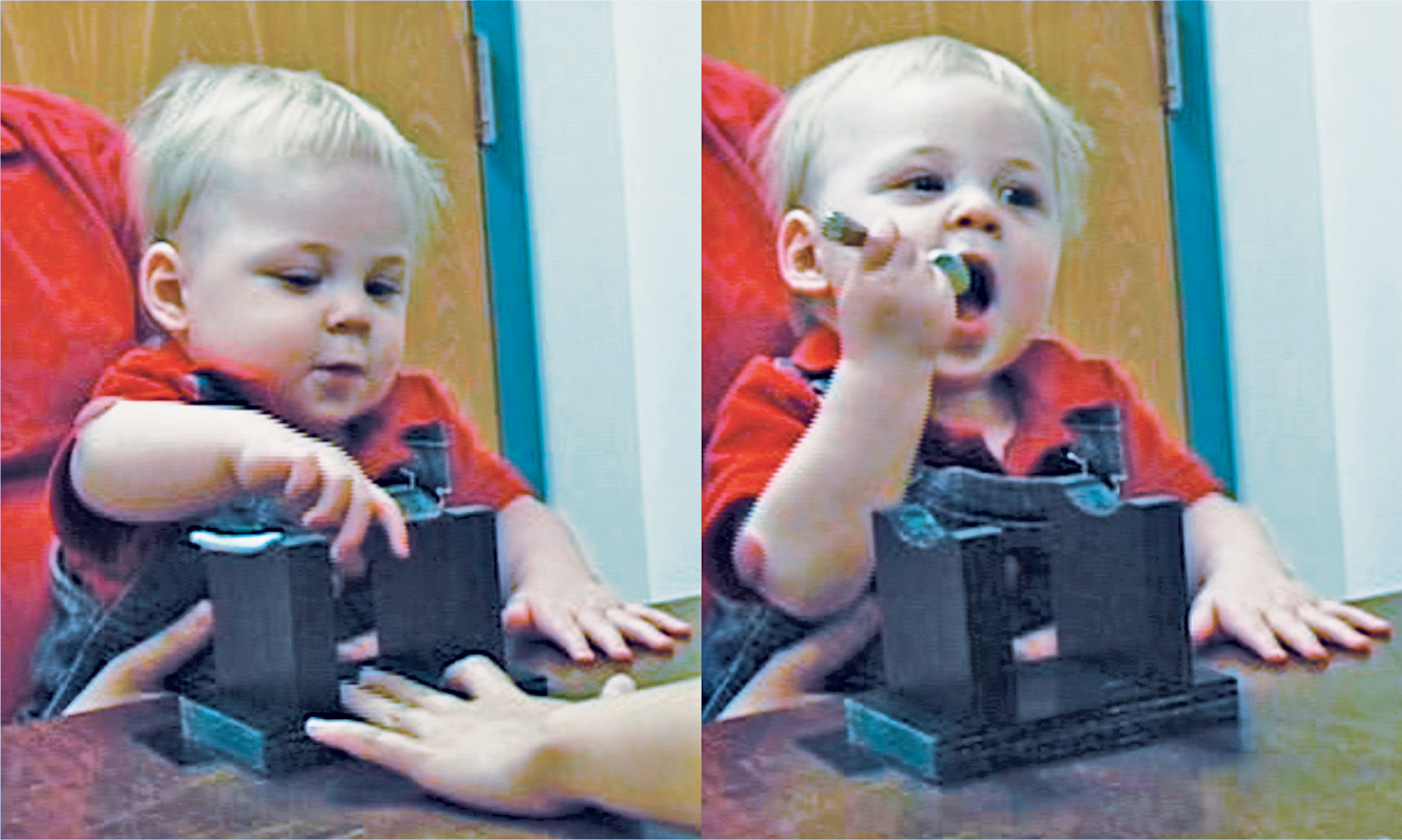
194
Self–Locomotion
At around 8 months of age, infants become capable for the first time in their lives of self-locomotion, that is, of moving around in the environment on their own. No longer limited to being only where someone else carries or puts them, their world must seem vastly larger to them.
Infants' first success at moving forward under their own power typically takes the form of crawling. (Box 5.4 describes a recent increase in variability in the onset of crawling.) Many (perhaps most) infants begin by belly crawling or using other idiosyncratic patterns of self–propulsion, one of which researchers refer to as the “inchworm belly–flop” style (Adolph, Vereijken, & Denny, 1998). Most belly crawlers then shift to hands–and–knees crawling, which is less effortful and faster. Other styles of crawling also have colorful names: bear crawls, crab crawls, spider crawls, commando crawls, and bum shuffles (Adolph & Robinson, 2013). The broader point is that infants are remarkably good at finding ways to get around prior to their being able to walfk.
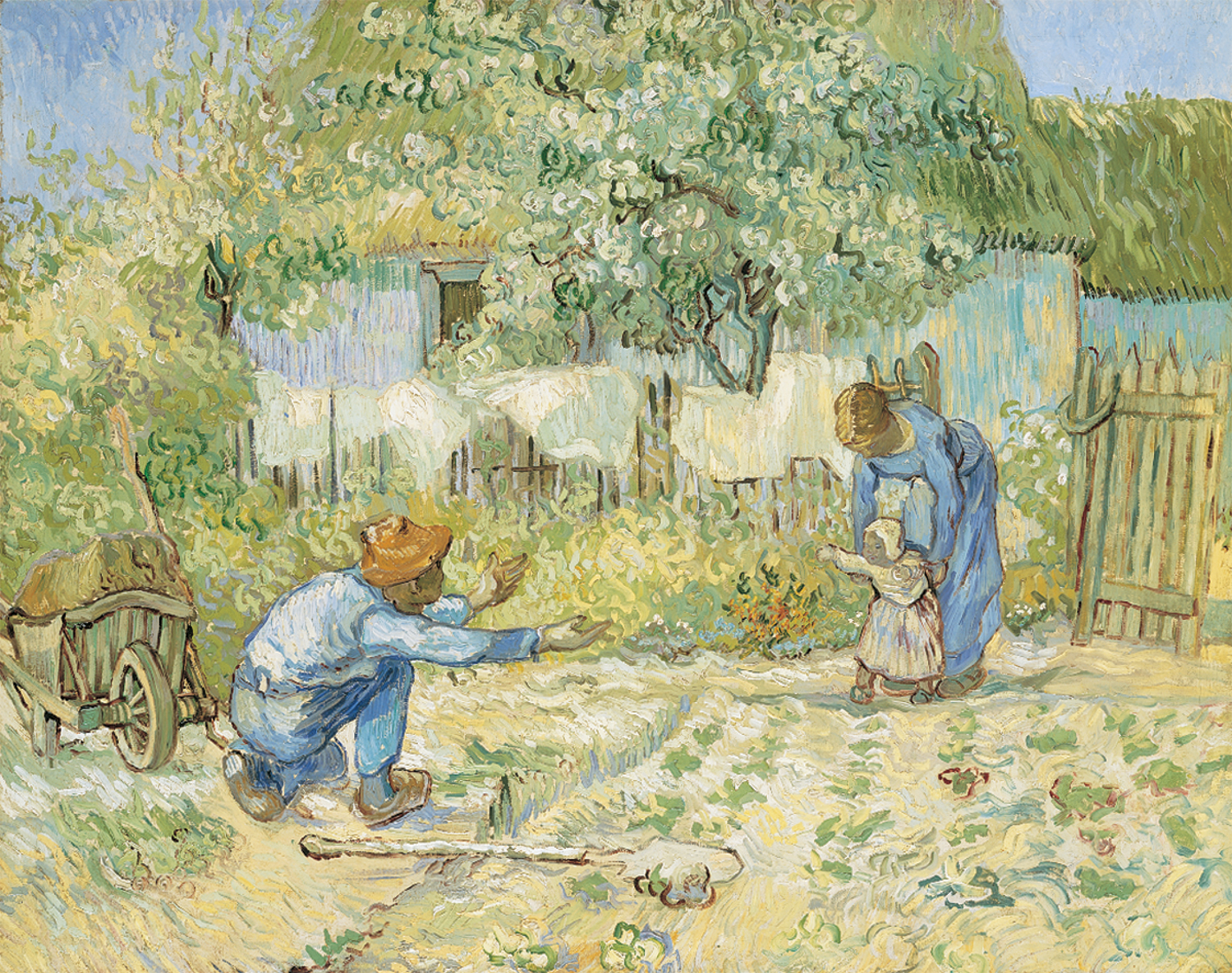
195
applications: A RECENT SECULAR CHANGE IN MOTOR DEVELOPMENT
In the late 1990s, pediatricians noticed a surprising increase in the number of visits they received from parents worried because their infants either began crawling quite late or never crawled at all. Many babies had simply gone from sitting to walking.
The cause for this genuine secular change in motor development seems to be traceable to the campaign, described in Box 2.4 (page 61), to get parents to put their babies to sleep on their backs (Davis et al., 1998). As we discussed in Chapter 2, this public health effort has been very successful in changing parents' behavior and has resulted in a remarkable reduction in the incidence of sudden infant death syndrome. However, it appears that regularly lying on their backs makes infants less likely to turn over on schedule. One source of this effect may be motivational: the better view of the environment that they have on their backs may lessen infants' motivation to roll over onto their stomachs, where the view is quite restricted. But, spending less time on their tummies, the babies have less opportunity to discover that they can propel themselves forward by squirming. With less practice pushing themselves up from lying on their stomachs, the infants' arm strength may develop somewhat more slowly.
In any event, the research is reassuring: when observed at 18 months, there was no developmental difference between infants who had crawled on schedule and those who had not.
When infants first begin walking independently, at around 11 to 12 months, they keep their feet relatively wide apart, which increases their base of support; they flex slightly at the hip and knee, thereby lowering their center of gravity; they keep their hands in the air to facilitate balance; and they have both feet on the ground 60% of the time (as opposed to only 20% for adults) (Bertenthal & Clifton, 1998). As they grow stronger and gain experience, their steps become longer, straighter, and more consistent. Practice is vital to infants' gradual mastery over their initially weak muscles and precarious balance (Adolph, Vereikjen, & Shrout, 2003). And practice they do: Adolph and colleagues (2012) found that their sample of 12– to 19–month–olds in New York City averaged 2,368 steps (and 17 falls) per hour!
The everyday life of the newly mobile crawler or walker is replete with challenges to locomotion—slippery floors, spongy carpets, paths cluttered with objects and obstacles, stairs, sloping lawns, and so on. Infants must constantly evaluate whether their developing skills are adequate to enable them to travel from one point to another. Eleanor Gibson and her colleagues found that infants adjust their mode of locomotion according to their perception of the properties of the surface they want to traverse (Gibson et al., 1987; Gibson & Schmuckler, 1989). For example, an infant who had promptly walked across a rigid plywood walkway would prudently revert to crawling in order to get across a water bed. Box 5.5 summarizes a program of research on the early development of locomotion and other forms of motor behavior in infancy, focusing specifically on the integration of perception and locomotion.
196
BOX 5.4: a closer look “GANGWAY—I’M COMING DOWN”
The interdependence of different developmental domains is beautifully illustrated by a rich and fascinating series of experiments conducted over five decades. This work started with a landmark study by Eleanor Gibson and Richard Walk (1960) that addressed the question of whether infants can perceive depth. It has culminated in research linking depth perception, locomotion, cognitive abilities, emotion, and the social context of development.
To answer the depth–perception question, Gibson and Walk used an apparatus known as the “visual cliff.” As the photo shows, the visual cliff consists of a thick sheet of plexiglass that can support the weight of an infant or toddler. A platform across the middle divides the apparatus into two sides. A checked pattern right under the glass on one side makes it look like a solid, safe surface. On the other side, the same pattern is far beneath the glass, and the contrast in the apparent size of the checks makes it look as though there is a dangerous drop–off—a “cliff”—between the two sides.
Gibson and Walk reported that 6– to 14–month–old infants would readily cross the shallow side of the visual cliff. They would not, however, cross the deep side, even when a parent was beckoning to them to come across it. The infants were apparently unwilling to venture over what looked like a precipice—strong evidence that they perceived and understood the significance of the depth cue of relative size.
Karen Adolph, who had been a student of Gibson, has conducted extensive research on the relation between perception and action in infancy. Adolph and her colleagues have discovered surprising discontinuities in infants' learning what they can and cannot accomplish with their developing locomotor and postural skills (Adolph, 1997, 2000; Adolph, Eppler, & Gibson, 1993; Adolph et al., 2003; Eppler, Adolph, & Weiner, 1996). This research exemplifies our theme of mechanisms of change, in which variation and selection produce developmental change.
As a way of studying the relation between early motor abilities and judgment, the investigators asked parents to try to entice their infants to lean over or crawl across gaps of varying widths in an elevated surface or to crawl or walk down sloping walkways that varied in how steep they were. Some of these tasks were possible for a given infant; the baby would have no trouble, for example, negotiating a slope of a particular steepness. Others, however, were impossible for that infant. Would the babies identify which tasks were which? (An experimenter always hovered nearby to catch any infant who misjudged his or her prowess.)
The photos below show how infants behaved on slopes when beckoned by an adult (usually their mother). In their first weeks of crawling, infants (averaging around 8½ months in age) unhesitatingly and competently went down shallow slopes. Confronted with slopes that were too steep to crawl down, the babies typically paused for a moment, but then launched themselves headfirst anyway (requiring the experimenter to catch hold of them). With more weeks of crawling practice, the babies got better at judging when a slope was simply too steep and should be avoided. They also improved at devising strategies to get down somewhat steep slopes, such as turning around and cautiously inching backward down the slope.
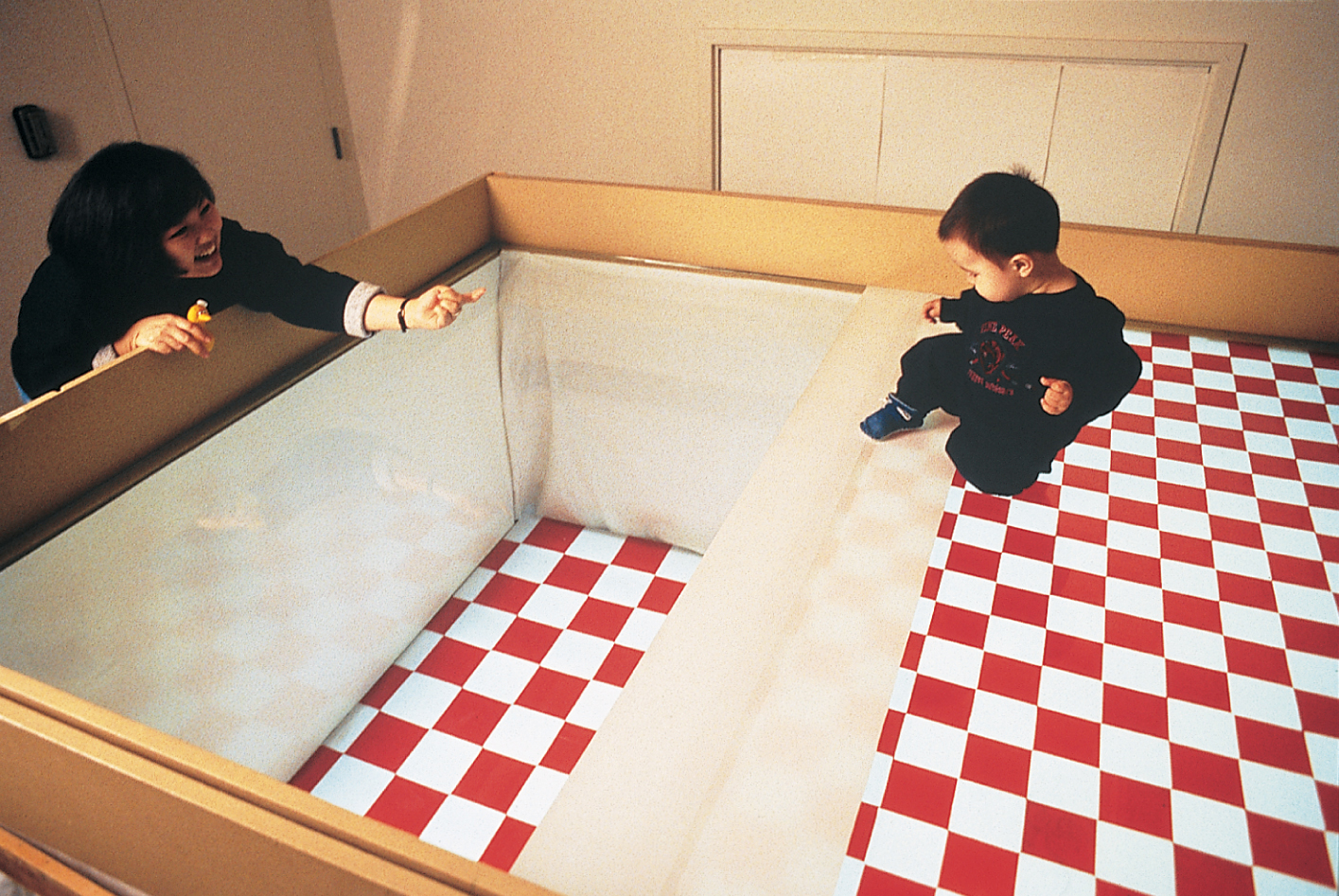
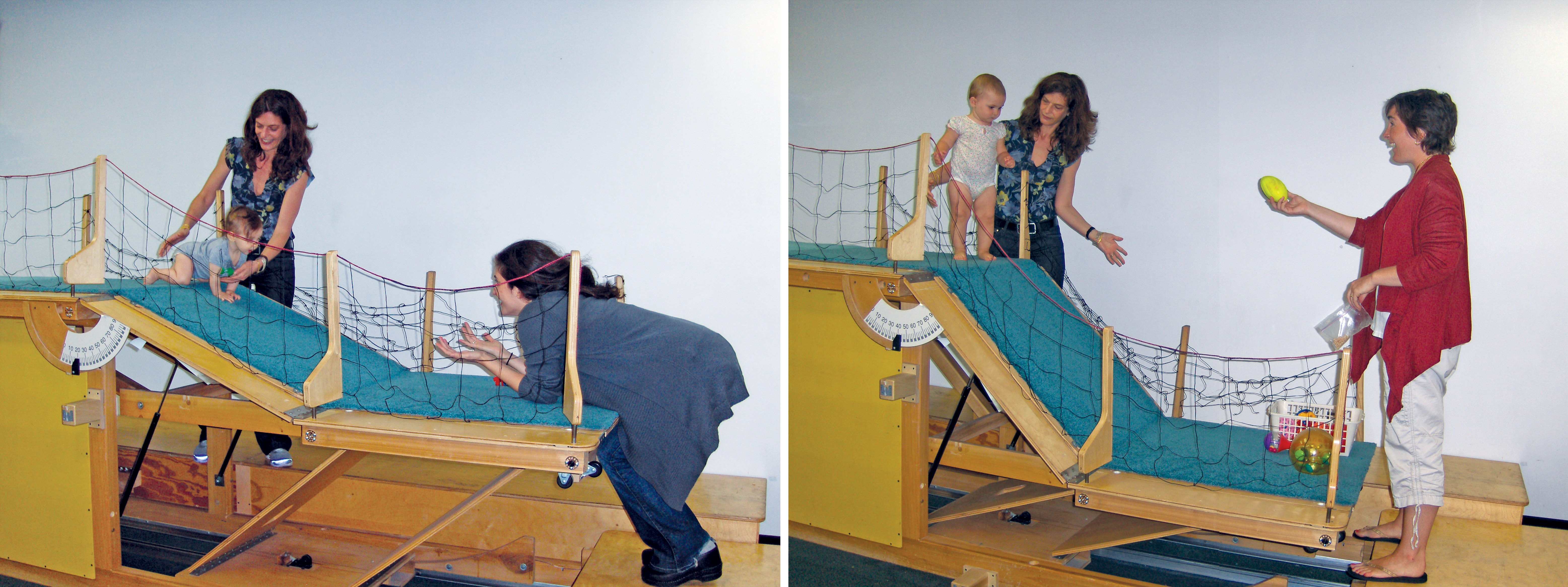
However, when the infants started walking, they again misjudged which slopes they could get down using their new mode of locomotion and tried to walk down slopes that were too steep for them. In other words, they failed to transfer what they had learned about crawling down slopes to walking down them. Thus, infants apparently have to learn through experience how to integrate perceptual information with each new motor behavior they develop. With experience comes increased flexibility, allowing access to multiple strategies for solving previously intractable problems, including laboratory–created challenges such as descending impossibly steep slopes or crossing narrow bridges with wobbly handrails (Adolph & Robinson, 2013).
Infants' decisions in such situations also depend on social information. Infants who are close to being able to make it down a relatively steep walkway can be rather easily discouraged from trying to do so by their mother telling them, “No! Stop!” Conversely, enthusiastic encouragement from a parent can lead an inexperienced crawler or walker to attempt a currently too–steep slope. Thus, the child uses both perceptual and social information in deciding what to do. In this case, the information is obtained through social referencing, the child's use of another person's emotional response to an uncertain situation to decide how to behave (see Chapter 10).
A key finding of Adolph's research is that infants have to learn from experience what they can and cannot do with respect to each new motor skill that they master. Just like the new crawlers and walkers who literally plunge ahead when put atop a sloping walkway, an infant who has just developed the ability to sit will lean too far out over a gap in a platform in an attempt to snag an out–of–reach toy and would fall over the edge if not for the ever–present reseacher–catcher. And, like the experienced crawlers and walkers who pause to make a prudent judgment about whether or not to try a descent, an infant who has been capable of sitting unsupported for some time can judge whether the gap is too wide to lean across and will stay put if it appears to be so. These highly consistent findings across a variety of motor skills have made a very important contribution to our understanding of how infants learn to interact successfully with their environment.
The challenge that young children experience in integrating perceptual information in the planning and execution of actions sometimes results in quite surprising behaviors, especially when children fail to meet the challenge. A particularly dramatic example of failure in the integration of perception and action is provided by scale errors (Brownell, Zerwas, & Ramani, 2007; DeLoache, Uttal, & Rosengren, 2004; Ware et al., 2006). In this kind of error, very young children try to do something with a miniature replica object that is far too small for the action to be at all possible. Toddlers will attempt, in all seriousness, to sit in a tiny, dollhouse–sized chair or to get into a small toy car (see Figure 5.12). In committing a scale error, the child momentarily fails to take into account the relation between his or her own body and the size of the target object. These errors are hypothesized to result from a failure to integrate visual information represented in two different areas of the brain in the service of action. With development, the incidence of scale errors diminishes, although even adults make a variety of action errors (e.g., putting a cup of water into the cupboard instead of the microwave or trying to squeeze into a too tight pair of pants).

197
198
review:
Typically developing infants display a similar sequence of milestones in the development of motor behavior, starting with a common set of neonatal reflexes. Although the timing of these milestones may differ across infants, and is affected by cultural differences, their order rarely varies. Researchers emphasize the pervasive interconnectedness between infants' motor behavior, perception, and motivation, as well as the many ways that infants' experience of the world changes as motor skills improve. In the development of self–locomotion (crawling, walking), infants adopt a variety of different movement patterns and strategies to get around and to cope with different environmental challenges. With experience, infants begin to develop the crucial ability to make accurate judgments about what actions they are and are not capable of performing.
